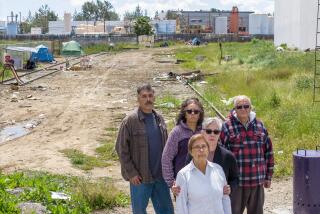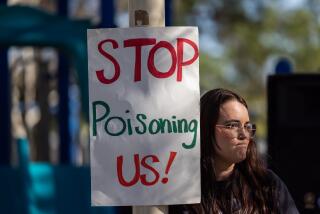Much of old Irvine air base is removed from list of hazardous sites
More than 1,900 acres of the retired Marine Corps Air Station El Toro in Irvine have been cleaned up and removed from the list of the nation’s most hazardous sites after more than two decades, the U.S. Environmental Protection Agency announced Monday.
Officials said that $165 million in soil removal and groundwater treatment by the U.S. Navy and local water agencies has cleaned up contamination at much of the old World War II-era air base, to the point it no longer poses a risk to human health or the environment.
The deletion of all but 600 acres of the El Toro site from the federal Superfund list, finalized last week, clears one obstacle to turning some of the old military property into the Orange County Great Park and thousands of homes.
“It will allow us to move forward with development of the Great Park in an accelerated manner,” said Jeff Lalloway, mayor pro tem of Irvine and chairman of the Great Park board of directors.
The 4,700-acre El Toro air base is one of 20 current and former Department of Defense facilities in California undergoing long and costly EPA cleanups, largely because of polluted soil and water. The list includes the former Norton Air Force Base near San Bernardino, Marine Corps Base Camp Pendleton in San Diego County and the former McClellan Air Force Base near Sacramento.
Built in 1942 to train pilots during World War II, El Toro was later developed into a permanent base for jet fighters on the West Coast.
El Toro was named to the Superfund list in 1990 because of contamination caused by decades of aircraft maintenance and repair, which left the soil laced with compounds known as polychlorinated biphenyls, or PCBs. A plume of groundwater tainted with trichloroethylene and other hazardous compounds migrated more than three miles from the base beneath Irvine. But wells in the area are used for irrigation, not as a source of drinking water.
For more than a decade, Irvine has tried to transform about 1,300 acres of the old base into a sprawling public park surrounded by homes and businesses. But the recession and the housing market collapse took a toll on the plan. Only about 230 acres of the park have been opened to the public, including its signature orange balloon ride, athletic fields, festival space and an arts complex.
“Being able to remove the Superfund name removes a stigma and helps the community grow,” said EPA Regional Administrator Jared Blumenfeld. “People should feel confident that they can play and recreate and use the land.”
Most of the 230 acres open to the public remain on the Superfund list because contaminated groundwater beneath it is still being treated. But the soil has been cleaned and no longer poses a health risk, EPA officials said. And the trichloroethylene in the groundwater, which sits about 100 feet below the surface, is at such low concentrations that it is close to meeting federal drinking water standards, they said.
After the base was decommissioned in 1999, the Navy auctioned off much of the property for $650 million through a 2005 deal with home builder Lennar Corp., which transferred about 1,300 acres in the middle of the base to Irvine to build the Great Park.
The portion of the Superfund site that was delisted includes about 700 acres of city-owned land, some of which is leased out for farming. The other 1,200 acres are being developed by FivePoint Communities, which has an agreement with the city to build 688 acres of public parkland in exchange for the rights to construct up to 9,500 homes nearby.
“FivePoint is gratified that this major milestone has been completed in the process of returning the former land of El Toro to productive, public use,” Chief Executive Emile Haddad said in a written statement.
Work to extract and treat groundwater and monitor capped landfills on remaining parts of the base list is expected to take years and an additional $50 million, according to the EPA.
“This has been a long, quiet, expensive process,” said Larry Agran, an Irvine councilman and Great Park board member. Still, he cautioned that more cleanup remains. “We have a number of areas that are still on the Superfund list, still require remediation and in some cases, pose a hazard.”







